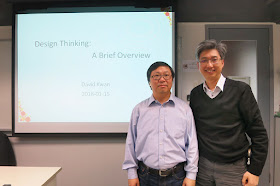The
seminar entitled "Design Thinking" was co-organizer by Institute of
Systematic Innovation Hong Kong (ISIHK), Hong Kong Quality Management
Association (HKQMA) and Six Sigma Institute (SSI) on 15th Jan 2018. Design Thinking originally is about
presentation of functions to their user and aesthetics is only part of design.
It is first started at IDEO and then was popularized by the design school (d.
school) of Stanford University which teaches of Design Thinking to people
beyond the design profession. The
seminar aimed to discuss the basic concept and application of Design
Thinking. I took a photo with Mr. David
Kwan for memory.
In the
beginning, Dr. Frankie, K.S. LAM (Chairman, HKQMA) introduced the guest speaker
Mr. David Kwan to us. Mr. Kwan is an
experience automation and mechanical system designer consultant and he is a
MATRIZ Level 3 Triz specialist.
Mr. David
Kwan (Founding Director, ISIHK) introduced the concept of Design Thinking. He
said he like the meaning of Design search from internet that “… a Rational
Presentation of Function…” Then he
quoted David Kelly (1978) who started at IDEO about Design Thinking
(Human-Centric Design) meant that “Apply the mentality of Designer to Solve
Problems” (employing Designer’s thinking logic).
And then David told us a story about Joe (Boss) and Mary (Subordinate) in which Mary was a supervisor in the warehouse of supermarket. He described some scenarios that you could observe some problems. How Design Thinking could help Joe?
After
that David briefed the process of Design Thinking that included Empathize,
Define, Ideate, Prototype and Test. He
employed the engineering terms (roughly) described 5 steps below:
Empathize: On-Site Observation & Data
Consolidation
Define: Problem Definition
Ideate: Brainstorming
Prototype & Test: Concept Simulation, Evaluation
& Feedback.
He added
those steps were not necessary in sequence and it could jump from one to
another depended on the need.
David
interpreted those terms one by one as follows.
He
quoted Bible to explain “Empathy” that “Do unto others as you would have them
do unto you”. Then he future interpreted
as “Put yourself into others’ shoes” (to feel) + “Open Mind” (to understand) + “Objectivity”
(to think). (He added that you could
understand and feel the person situation but you may not agree with him.)
The most
important of “Empathy” was to discover people’s real and hidden needs, motives and their underneath emotions that
guides their behavior into order to ensure we solve the right problem.
“Define”
step is to review data to find the user’s feeling and physical and emotional
needs and re-state / reframe as a problem statement. He quoted Forbes that top 20 reason why
startup fail was no market need. That’s
why empathize plus define so important!
“Ideate”
step that brainstorm was employed for ideas such as use Story to elaborate your
ideas and select ideas based on potential and not feasibility. At the time, Dr. Micheal Li added TRIZ could
trigger some ideas in this step.
“Prototype”
step that build “physical prototype” to explore your ideas and to verify your problem
definition. He added this term may be
misleading and now somebody employed “Pre-prototype or Pretotype”.
“Test”
step used to refine your idea; to learn more about your user and verify your
problem statement, as well as, to validate your idea at the final phase.
Finally,
David showed us “Design Thinking is not a Linear Process”. It was a cycle fail and trial fast to test
your problem and solution. He added the “Creativity”
kicked in during Problem Finding. Even
though Solution Finding also introduced “Creativity” but Problem Finding was
more important.
Lastly,
he briefed the Design Thinking Mindsets to us below.
Curiosity
– Opportunity is often the result of Keen
Observation.
Reframing
– Looking for Alternative View Point
Mindfulness
of Process – Don’t Sidetrack
Radical
Collaboration – Nobody knows everything. (Idea
Cross Pollination)
Action
Orientated – Don’t be afraid of Failure.
Learn from it. (I said to try in controlled area like Fintech Sandbox.)
At the
end, he introduced “Abductive Reasoning that thinking in terms of
probability. (Accepting a possible
explanation for an observation according to previous known facts) Then he pointed out Tamed Problem (e.g. solve
problem to arrive in Mars) and Wicked Problem (e.g. solve problem to celebrate Valentine’s
Day). David recommended us to read three
articles about it.
We had
discussed different items during Q&A session.
Lastly, Dr.
Frankie, K.S. LAM (Chairman, HKQMA) took a photo with Mr. David Kwan for
memory.
Reference:
HKSQ - www.hksq.org
Institute
of Systematic Innovation, HK - http://www.isi.org.hk/
HKQMA - http://www.hkqma.org/
20151110:
HKSTP Design Thinking Seminar on Customer Services - https://qualityalchemist.blogspot.hk/2015/11/hkstp-design-thinking-seminar-on.html
20151207:
HKSTP Design Thinking Seminar on Management - https://qualityalchemist.blogspot.hk/2015/12/hkstp-design-thinking-seminar-on.html
20160505:
HSMC Seminar on Entrepreneurial Spirit and Sustainable Development Mindset - https://qualityalchemist.blogspot.hk/2016/05/hsmc-seminar-on-entrepreneurial-spirit.html
(where Hang
Seng Management College (HSMC) employed Design Thinking in Education.)












沒有留言:
發佈留言